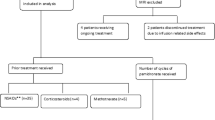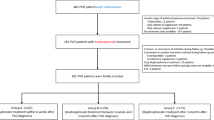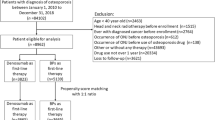Abstract
Objectives
To assess the efficacy of bisphosphonate therapy on bone pain in patients with osteoid osteoma (OO) (main objective), and to describe bisphosphonate-induced changes in nidus mineralisation and regional bone-marrow oedema (BMO).
Methods
A prospective, observational study was conducted from 2011 to 2014. Patients with risk factors for complications of percutaneous or surgical ablation or recurrence after ablation, were offered once monthly intravenous bisphosphonate treatment until significant pain alleviation was achieved.
Results
We included 23 patients. The first two patients received pamidronate and the next 21 zoledronic acid (mean, 2.95 infusions per patient). Bisphosphonate therapy was successful in 19 patients (83%), whose mean pain visual analogue scale score decreased by 76.7%; this pain-relieving effect persisted in 17 patients (74%) with a mean follow-up time of 36 months. Computed tomography (CT) demonstrated a mean nidus density increase of 177.7% (p = 0.001). By magnetic resonance imaging (MRI), mean decreases were 38.4% for BMO surface area and 30.3% for signal intensity (p = 0.001 and p = 0.000, respectively).
Conclusions
In 17/23 patients with painful OO managed conservatively with bisphosphonates, long-term final success was achieved. Bisphosphonates may accelerate the spontaneous healing of OO.
Key points
• 19/23 patients with OO managed with bisphosphonates experienced significant pain relief
• Pain relief was sustained in 17/23 patients, mean follow-up of 36 months
• CT demonstrated a significant increase in nidus mineralisation
• MRI demonstrated a significant decrease in bone marrow oedema
• Bisphosphonate therapy may accelerate the spontaneous healing of OO


Similar content being viewed by others
Abbreviations
- BMO:
-
bone-marrow oedema
- BMO Ar:
-
BMO surface area
- BMO In:
-
mean BMO signal intensity
- BM Ref:
-
mean signal intensity in a region of interest of normal bone marrow
- NID Ar AX :
-
nidus area in the axial plane
- NID Ar Long :
-
nidus area in the longitudinal plane
- NID Ar Mean :
-
mean nidus area
- NID Dens:
-
mean CT density within the nidus area
- NSAIDs:
-
non-steroidal anti-inflammatory drugs
- OO:
-
osteoid osteoma
References
Jaffe H (1935) “Osteoid osteoma”. A benign osteoblastic tumor composed of osteoid and atypical bone. Arch Surg 31:709–728
Klein MH, Shankman S (1992) Osteoid osteoma: radiologic and pathologic correlation. Skelet Radiol 21:23–31
Makley JT, Dunn MJ (1982) Prostaglandin synthesis by osteoid osteoma. Lancet 2:42
Gangi A, Alizadeh H, Wong L, Buy X, Dietemann J-L, Roy C (2007) Osteoid osteoma: percutaneous laser ablation and follow-up in 114 patients. Radiology 242:293–301
Rybak LD, Gangi A, Buy X, La Rocca Vieira R, Wittig J (2010) Thermal ablation of spinal osteoid osteomas close to neural elements: technical considerations. AJR Am J Roentgenol 195:293–298
Boonekamp PM, van der Wee-Pals LJ, van Wijk-van Lennep MM, Thesing CW, Bijvoet OL (1986) Two modes of action of bisphosphonates on osteoclastic resorption of mineralized matrix. Bone Miner 1:27–39
Fournier PG, Stresing V, Ebetino FH, Clézardin P (2010) How do bisphosphonates inhibit bone metastasis in vivo? Neoplasia 12:571–578
Arzoo K, Sadeghi S, Pullarkat V (2001) Pamidronate for bone pain from osteolytic lesions in Langerhans’-cell histiocytosis. N Engl J Med 345:225
Chapurlat RD, Delmas PD, Liens D, Meunier PJ (1997) Long-term effects of intravenous pamidronate in fibrous dysplasia of bone. J Bone Miner Res 12:1746–1752
Cornelis F, Truchetet ME, Amoretti N et al (2014) Bisphosphonate therapy for unresectable symptomatic benign bone tumors: a long-term prospective study of tolerance and efficacy. Bone 58:11–16
Vickers C, Pugh D, Ivins J (1959) Osteoid osteoma. A fifteen-year follow-up of an untreated patient. J Bone Jt Surg 41:357–358
Coleman RE, McCloskey EV (2011) Bisphosphonates in oncology. Bone 49:71–76
Högler W, Yap F, Little D, Ambler G, McQuade M, Cowell CT (2004) Short-term safety assessment in the use of intravenous zoledronic acid in children. J Pediatr 145:701–704
Munns CF, Rajab MH, Hong J et al (2007) Acute phase response and mineral status following low dose intravenous zoledronic acid in children. Bone 41:366–370
Brown JJ, Zacharin MR (2009) Safety and efficacy of intravenous zoledronic acid in paediatric osteoporosis. J Pediatr Endocrinol Metab 22:55–63
de Berg JC, Pattynama PM, Obermann WR, Bode PJ, Vielvoye GJ, Taminiau AH (1995) Percutaneous computed-tomography-guided thermocoagulation for osteoid osteomas. Lancet 346:350–351
Goto T, Shinoda Y, Okuma T et al (2011) Administration of nonsteroidal anti-inflammatory drugs accelerates spontaneous healing of osteoid osteoma. Arch Orthop Trauma Surg 131:619–625
Kneisl JS, Simon MA (1992) Medical management compared with operative treatment for osteoid-osteoma. J Bone Joint Surg Am 74:179–185
Yanagawa T, Watanabe H, Shinozaki T, Ahmed AR, Shirakura K, Takagishi K (2001) The natural history of disappearing bone tumours and tumour-like conditions. Clin Radiol 56:877–886
Ilyas I, Younge DA Medical management of osteoid osteoma. Can J Surg 45:435–437
Coulier B, Mailleux P, Munting E (2005) Spontaneous remission of an osteoid osteoma of the axis. JBR-BTR 88:43
Jayakumar P, Harish S, Nnadi C, Noordeen H, Saifuddin A (2007) Symptomatic resolution of spinal osteoid osteoma with conservative management: imaging correlation. Skelet Radiol 36:S72–S76
Aiba H, Hayashi K, Inatani H et al (2014) Conservative treatment for patients with osteoid osteoma: a case series. Anticancer Res 34:3721–3725
Yokouchi M, Nagano S, Shimada H et al (2014) Early complete remission of osteoid osteoma with conservative medical management. Pediatr Rep 6:5311
Touraine S, Emerich L, Bisseret D, Genah I, Parlier-Cuau C, Hamze B, Petrover D, Laredo JD, Bousson V (2014) Is pain duration associated with morphologic changes of osteoid osteomas at CT? Radiology 271(3):795–804. doi:10.1148/radiol.14131629
Fuchs S, Gebauer B, Stelter L et al (2014) Postinterventional MRI findings following MRI-guided laser ablation of osteoid osteoma. Eur J Radiol 83:696–702
de Chadarévian J-P, Katsetos CD, Pascasio JM, Geller E, Herman MJ (2007) Histological study of osteoid osteoma’s blood supply. Pediatr Dev Pathol 10:358–368
Klein MJ, Parisien MV, Schneider-Stock R (2002) Osteoid osteoma. In: Fletcher CDM, Unni KK, Mertens F (eds) Pathology and genetics—tumors of soft tissue and bone. IARC Press, Lyon, pp 260–261
Wood J, Bonjean K, Ruetz S et al (2002) Novel antiangiogenic effects of the bisphosphonate compound zoledronic acid. J Pharmacol Exp Ther 302:1055–1061
Igarashi K, Hirafuji M, Adachi H, Shinoda H, Mitani H (1997) Effects of bisphosphonates on alkaline phosphatase activity, mineralization, and prostaglandin E2 synthesis in the clonal osteoblast-like cell line MC3T3-E1. Prostaglandins Leukot Essent Fat Acids 56:121–125
Mungo DV, Zhang X, O’Keefe RJ, Rosier RN, Puzas JE, Schwarz EM (2002) COX-1 and COX-2 expression in osteoid osteomas. J Orthop Res 20:159–162
Acknowledgements
We thank all the patients and investigators for their participation, the staff members who participated in patient inclusion, and Ms. Olivia Tran for phone calls to patients.
Author information
Authors and Affiliations
Corresponding author
Ethics declarations
Guarantor
The scientific guarantor of this publication is Prof. Philippe Orcel.
Conflict of interest
The authors of this manuscript declare no relationships with any companies, whose products or services may be related to the subject matter of the article.
Funding
The authors state that this work has not received any funding.
Statistics and biometry
No complex statistical methods were necessary for this paper.
Informed consent
Written informed consent was obtained from all subjects (patients) in this study.
The study is currently registered on a WHO-compliant registry. In addition we are starting a multicentre randomised trial comparing percutaneous ablation to bisphosphonate therapy (the ongoing observational study and the randomised trial are registered at ClinicalTrials.gov; ID, NTC02739555).
Ethical approval
Institutional Review Board approval was obtained.
Study subjects or cohorts overlap
Some study subjects or cohorts have been previously reported in Dynamic contrast-enhanced MR imaging in osteoid osteoma: relationships with clinical and CT characteristics. Pottecher P, Sibileau E, Aho S, Hamze B, Parlier C, Laredo JD, Bousson V. Skeletal Radiol. 2017 Jul;46(7):935-948. doi: 10.1007/s00256-017-2645-2. Epub 2017 Apr 11. PMID: 28401265 and Is pain duration associated with morphologic changes of osteoid osteomas at CT? Touraine S, Emerich L, Bisseret D, Genah I, Parlier-Cuau C, Hamze B, Petrover D, Laredo JD, Bousson V. Radiology. 2014 Jun;271(3):795-804. doi: 10.1148/radiol.14131629. Epub 2014 Feb 1. PMID: 24495266
Methodology
• prospective
• observational
• multicentre study (two centres)
Rights and permissions
About this article
Cite this article
Bousson, V., Leturcq, T., Ea, HK. et al. An open-label, prospective, observational study of the efficacy of bisphosphonate therapy for painful osteoid osteoma. Eur Radiol 28, 478–486 (2018). https://doi.org/10.1007/s00330-017-5019-1
Received:
Revised:
Accepted:
Published:
Issue Date:
DOI: https://doi.org/10.1007/s00330-017-5019-1




